| Release List | Reviews | Price Search | Shop | Newsletter | Forum | DVD Giveaways | Blu-Ray/ HD DVD | Advertise |
| Reviews & Columns |
|
Reviews DVD TV on DVD Blu-ray International DVDs Theatrical Reviews by Studio Video Games Features Collector Series DVDs Easter Egg Database Interviews DVD Talk TV DVD Talk Radio Feature Articles Columns Anime Talk DVD Savant HD Talk Horror DVDs Silent DVD
|
DVD Talk Forum |
|
|
| Resources |
|
DVD Price Search Customer Service #'s RCE Info Links |
|
Columns
|
 |
The Val Lewton Collection
|
||||
Read anything critically comparative about horror movies and one will more likely than not run into a footnote or a remark that references producer Lewton's positive influence on the genre. Much like Preston Sturges, in the 1940s Lewton had a brief but productive run of personal productions that all but eclipsed the efforts of others in his field. Although Lewton would rather have been doing literary adaptations or period pieces his string of unprepossessing modern-day horror chillers gave him free reign to express his ideas about fear and the unknown. As a result, the Universal-style monster rallies of the 1940s are now mostly dated amusements, while Lewton's productions remain as powerful as the day they premiered. In the mid 1990s Image Entertainment put out a pricey laserdisc box of the nine Val Lewton horror thrillers, and Warners now brings us a five-disc DVD set covering the same titles. They're double-billed as were the older Universal monster movies, with room on the covers for reproductions of the films' original stone-litho insert poster artworks. There is no lack of good resources on Val Lewton. Joel E. Siegel's book The Reality of Terror is still Savant's favorite overview. A website called The Val Lewton Screenplay Collection is a wonderful source for original scripts, essays, reviews and even Val Lewton's original short story The Bagheeta, a source for ideas in Cat People. 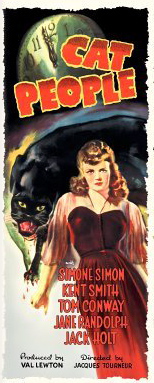
Cat People 1942 / 74 min. / Co-billed with Curse of the Cat People Starring Simone Simon, Kent Smith, Tom Conway, Jane Randolph, Jack Holt, Elizabeth Russell Cinematography Nicholas Musuraca Art Direction Albert S. D'Agostino, Walter E. Keller Film Editor Mark Robson Original Music Roy Webb Written by De Witt Bodeen Directed byJacques Tourneur Val Lewton landed his B-Unit deal at RKO and hit the ground running. Part of his success has to be attributed to a clear mission statement from above: With the purging of Orson Welles from the lot ("Showmanship, not genius!") Lewton was ordered to turn out inexpensive horror films that would do well at the box office and offset the losses of costly artistic movies. He was handed infuriatingly trashy ready-made titles that were sort of a blessing in disguise -- who could blame him if a movie called Cat People wasn't a huge hit? If it did at all well, it would be considered a triumph. Cat People became a triumphant hit that secured Lewton's producership and allowed him to build his own little department of civilized horror filmmakers. Editor Mark Robson was assigned there almost as punishment for his work with Orson Welles, but quickly realized that the creative buzz around Lewton could become a career booster. The Lewton unit would become a springboard to the big time for Robson, editor Robert Wise and the previously obscure director Jacques Tourneur. Cat People is a bona-fide classic and a screen original that defines the Lewton approach by basing its terror not in supernatural monsters but in psychological problems. The De Witt Bodeen screenplay (reportedly heavily re-written by Lewton, as were all of his films) presents convincing characters in ordinary adult situations and then sneaks the supernatural content in through the side door. Lewton's sources of terror would often be related to sexual problems compounded by negative emotions, like jealousy.
Joel E. Siegel nailed why Cat People connects with audiences better than a movie like, say, The Mummy's Ghost. Lewton's people live in the real world, holding down jobs and making plans for the future. There are no mad scientists or foreign mountebanks with reanimated corpses in their cabinets. If someone feels the influence of the occult or an hereditary curse, they themselves are in doubt about it. A 'business as usual' mood predominates. People get tired or out of sorts. Leading characters don't have pals to provide comic relief and romantic leads sometimes turn out to be thoughtless clods, as Oliver Reed does in this movie. Cat People gave 1942 audiences a lot to think about. Irena Dubrovna has personal problems that can't be helped by marriage to a patient nice guy. Oliver doesn't have enough imagination to realize that he's the key to her happiness. It's a case of Bad Timing -- she crouches on one side of a door hoping for a sign that Oliver can overcome her fear. Oliver is tolerant but incapable of understanding Irena or interpreting her words and moods. He violates her confidence by discussing the problem with another woman, something Irena takes very personally. When she tries to give the marriage an honest try he's already made up his mind that it's a bust. Unhappy people are capable of doing great harm and Irena's feline curse seems almost beside the point. (spoilers)Many horror critics point out the fact that Tourneur and Lewton wanted to keep the whole cat transformation business ambiguous, an idea the front office would never accept. The leopard is easily seen in the shadows of the drafting room and the fur-covered corpse at the end (Oliver and Alice just walk away and leave her there!) looks suspiciously like a dead panther. Without a real cat curse there's no explanation for Elizabeth Russell's creepy scene ("Moi-ra sestra?"), unless both cat women are neurotics from a similar background. The balance between the rational and the supernatural and how much of the threat needs to be shown are always debatable, as can be seen in Tourneur's triumphant return to the Lewton style fifteen years later in Night of the Demon. Much is made of Lewton's reported cat phobia but the real scares in Cat People come mostly from unnerving little lapses of personal security that everyone experiences -- the feeling of being followed or watched. Lewton likes to put his characters in vulnerable positions, as when Alice feels trapped in her apartment building's basement pool. And there is of course the nighttime walk with its famous 'bus' moment. It's curious that few people object that Irena's muddy paw prints magically transform into high heel prints on the sidewalk. As does Dracula in some pictures, she apparently can change physical form and still retain her clothing. Forties' thrillers and films noir discovered Freud in a big way and Cat People was one of the earliest to feature an unscrupulous psychiatrist. Tom Conway's oily smooth-talker says things like, "What does one tell a husband? One tells him nothing" to indicate his desire for Irena. Audiences surely responded positively when Irena takes the opportunity to exercise her bestial needs on such an appropriate target. Linwood Dunn applied an optical filter and eye highlight to Irena's close-up for her on-screen transformation, a great moment for subtlety -- viewers didn't need Jack Pierce makeup effects to know what Irena was doing. Warners' DVD of the melancholy Cat People is among the better-looking transfers in the set. It looks good but is not an outstanding restoration. The audio on all of the titles is very smooth, indicating they were worked over carefully for pops and distortion. Author Greg Mank delivers a learned commentary for this film and its sequel The Curse of the Cat People. He gives details of Lewton's background and has plenty of facts about Simone Simon accompanied by interview bites from the elderly French actress, who just earlier this year at the age of 93. I've never seen original-quality trailers for the Lewton films; the ones here are dupey and ragged and end with re-issue title cards. I bought a set of them on 16mm back in the 1970s and played them frequently - before Home Video, screenings of Lewton pictures were few and far between. 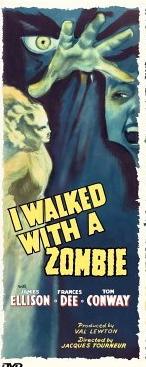
I Walked with a Zombie 1943 / 69 min. / Co-billed with The Body Snatcher Starring Frances Dee, Tom Conway, James Ellison, Christine Gordon, Edith Barrett, Sir Lancelot, Darby Jones Cinematography J. Roy Hunt Art Direction Albert S. D'Agostino, Walter E. Keller Film Editor Mark Robson Original Music Roy Webb Written by Curt Siodmak, Ardel Wray Directed byJacques Tourneur Before Cat People became a surprise hit Lewton and Tourneur were already shooting their next film, again saddled with a ridiculous title. The Caribbean location for this movie required great ingenuity and cleverness to pull off on the tiny budget and it is obvious from the result that RKO's fine technical departments did their best for Val Lewton's unit. It's a 'B Picture' that in its visual look outdoes the 'A's'.
I Walked with a Zombie is Lewton's most critically acclaimed film. Replete with creepy incidents and jolting surprises, Zombie's brief scenes quickly advance its "Jane Eyre in the West Indies" storyline while giving an impression of a leisurely pace. J. Roy Hunt's photography is an object lesson in how to indicate a tropical ambience on a Gower Street soundstage. Light frequently filters through trees, blinds and gratings before reaching the faces of the actors. Classic scenes seem to creep up on us -- the most evocative sequence consists of tracking shots through some cane fields that in actuality must be a very small stage set. The voodoo dances and rituals are said to be authentic, and Lewton embellishes them with little cultural details to create an impression of a sad island of lost souls. The ex-slaves weep at births and make merry at funerals while retaining a cultural defiance of white rule through their voodoo religion. Calypso singer Sir Lancelot sings The Ballad of the Hammonds as a barbed protest, a thinly disguised threat against Betsy as she tries to rouse the drunken Wesley. It is the film's most inspired moment. This 'political' use of voodoo gives rise to thoughts that the Hammonds are cursed by their past history as slavers, even though nobody in the movie verbally acknowledges such a thing. Paul Hammond is certainly aware of the sadness of life on the island. An old buggy driver is politely deferential when Betsy innocently says the slaves must have been happy to be brought to such a beautiful place: "If you say so, miss, if you say so." Lewton's fame as the inventor of the psychological horror film is largely due to his mastery of narrative ambiguity. Zombie is made twice as interesting by not revealing certain vital facts, hiding the truth just as Lewton replaced Universal-style monster menaces with darkness. The 'secret' of the Hammonds has an integral function in the film's theme. In Zombie, belief in the supernatural is but one of many faults in the human character. The script never confirms the reality of Voodoo even when it is clear that the Voodoo masters are controlling the zombie Carre-Four. It's worth noting that Wesley 'falls under the voodoo spell' only after despairing of the hopeless state of affairs at the Hammond house, and sinking into a deep depression. Lewton seemed to be a man with a deep understanding of isolation and depression. Betsy nurses Jessica, a catatonic woman whose past is the key to a rivalry between brothers and the domination of an entire island by the slow decay of voodoo worship. Although we hear inconclusive details and veiled references to her pre-zombie personality and deeds, Jessica cannot speak for herself. Betsy can look into Jessica's eyes but cannot know for sure who is responsible for the original source of discontent. Paul Holland admits to driving his wife away with mental cruelty. Wesley obviously wanted Jessica for himself. Mother purposely tried to stop Jessica from breaking up the family. And now comes Betsy. She wants to do the right thing but is aware of her own personal agenda -- she feels guilty in the knowledge of how convenient it would be if Jessica were truly out of the way. 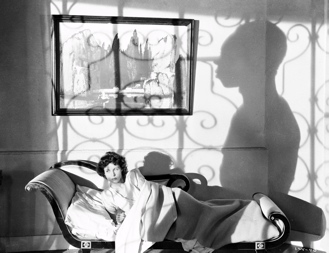
Lewton's theme is that human nature creates Evil -- that unresolved guilt and suspicions from the past dominate the Hammond family's present. Better natures are stifled, starting a chain of human misery that leads to tragedy. The result -- wasted lives and blighted vitality -- is as pervasive as the creeping Voodoo beliefs themselves. The acting is unusually good for a Lewton picture. Frances Dee, Tom Conway and Edith Barrett are excellent and the only weak link is James Ellison, who is pretty feeble as a surly alcoholic. Christine Gordon is appropriately chilling and the many black actors playing interesting non-stereotyped roles are topped by Teresa Harris' Alma (Tourneur used her again in Out of the Past), Sir Lancelot and Jeni LeGon as the voodoo swordsman. Darby Jones' Carre-Four is used as a quietly chilling proof that Voodoo zombie craft exists. I Walked with a Zombie is breathtaking on a screen in 35mm, with much more detail than could be expected to show up on NTSC video. This title was one of the worst looking of all the Lewtons previously out on tape and disc, and Warners' new transfer is an improvement with reservations. The picture is a bit more detailed and less contrasty than I've seen it but a couple of reels have a some unsteadiness and jitter in some parts of the image, as if shrinkage had made a transfer difficult. English critics Kim Newman and Steve Jones double up for a commentary on I Walked with a Zombie to dispense insights and good-natured chatter. We learn that a popular magazine story inspired this zombie picture in the same way that a late 1920s book about Voodoo was the impetus for White Zombie ten years earlier. The trailer is again a worn dupe from a reissue. 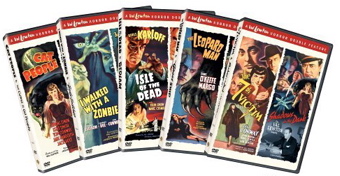
The Leopard Man 1943 / 66 min. / Co-billed with The Ghost Ship; not available individually Starring Jean Brooks, Dennis O'Keefe, Margo, Isabel Jewell, James Bell, Abner Biberman Cinematography Robert de Grasse Art Direction Albert S. D'Agostino, Walter E. Keller Film Editor Mark Robson Original Music Roy Webb Written by Ardel Wray from a story Black Alibi by Cornell Woolrich Directed by Jacques Tourneur Although it performed well at the box office The Leopard Man is nobody's favorite and has dated more than most of the other Lewton titles. It was an experiment, an attempt by Lewton and Jacques Tourneur to create a movie where a murder or other frightening event happened every ten minutes or so. In structure it predates the Italian giallo horror films that started with Mario Bava's Blood and Black Lace twenty years later. Despite its unevenness, the film boasts several unforgettable moments.
The Leopard Man stretches Lewton's RKO resources a little thin. Kiki and Jerry are in a small New Mexico town that is obviously a redressed 'New York Street' studio set with high curbstones and brick buildings. It's too bad that location shooting wasn't practical in 1943 as Los Angeles had many Mexican-American neighborhoods that could have provided good backgrounds. The inability to hire Latino actors is also a problem as Lewton was probably forced to hire bit players already on the RKO payroll. Of all the actors only Margo is convincingly Latin; everyone else struggles with Spanish phrases. The birthday song Las Mañanitas is heard in English, and we never for a moment believe the setting. Ardel Wray's script and Tourneur's direction play some adventurous games with the thriller narrative. The movie begins with singer Kiki (who we never hear sing) but chooses to follow flamenco dancer Clo-Clo (Margo of Lost Horizon and Crime Without Passion) when she leaves the nightclub for home. In the middle of tracking her down a street, the camera suddenly changes its mind to fixate on a brand-new character, a young girl sent out to the grocery store at night. For a few moments the camera seems to be playing its own game of chance, in keeping with the 'fate' theme represented rather dully by a ball suspended above a fountain. The Leopard Man uses literal symbols, something that Lewton usually scrupulously avoided or concealed more cleverly. The Leopard Man frequently ditches its main characters and leaves Jean Brooks and Dennis O'Keefe to play uninteresting scenes about their feelings of responsibility over the leopard disaster. Like Mario Bava's stylish murder stories and Dario Argento's gore-fests, the emphasis is on the individual deaths. After the first example we immediately sense that any new female character we meet is a candidate for killing. All of the murders are discreet, showing us only preliminaries and a terrified reaction as the killer closes from off-screen. The most famous one is shockingly cruel. (spoiler) We've barely met a young girl and suffer with her as her mother unreasonably forces her to go out into the night alone. A terrifically effective 'bus' occurs in a dry wash, and then a leopard pursues the girl to her own front door, where she screams to be let inside. Mother ignores her as a punishment, only to be confronted by a thick stream of blood trickling under the door. Blood wasn't usually shot this way in 1943 and the scene is brutally effective. The killer turns out to be (more spoilers) a college-educated intellectual. Mad killers of the 40s are often suspicious aesthetes. Interestingly, when cornered he doesn't rave like a madman but tries to explain himself and his sickness. It's typical of Lewton to extend sympathy even to his villains. But what we remember most in The Leopard Man are the heartless murder scenes. Jean Brooks is subdued and Dennis O'Keefe seems to be marking time, leaving Margo to make the film's strongest impression -- when Clo-Clo exits the fun goes out of the picture. The cast includes regulars Ben Bard (fairly colorless as a sheriff) and Abner Biberman as an okay Indian showman. Isabel Jewell is in as a rather corny fortune teller. Pretty-boy Keefe Brasselle just happens to make a convincing Mexican-American. Perhaps one reason that the film doesn't have the usual Lewton feel is that the main characters are show-biz people -- the dialogue humanizes their problems, but they still don't seem like working folks. The transfer of The Leopard Man is sharp and well-defined but has a lot of dirt built into the film element, especially on the titles and during the frequent nighttime scenes. The crisp audio allows us to enjoy Margo's restrained but elegant castanet dance -- and to see that the castanets are post-dubbed. Director William Friedkin gives yet another appreciation-oriented commentary, talking us through what we can already see on screen. He recites bland generalities about horror and Lewton's technique as if they were nuggets of great wisdom. It's a truly unrewarding listen. A trailer is included for this title as well. 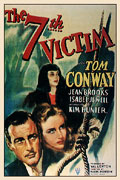
The Seventh Victim 1943 / 71 min. / Co-billed with Shadows in the Dark: The Val Lewton Legacy; not available individually Starring Kim Hunter, Jean Brooks, Tom Conway, Isabel Jewell, Elizabeth Russell, Evelyn Brent, Hugh Beaumont Cinematography Nicholas Musuraca Art Direction Albert S. D'Agostino, Walter E. Keller Film Editor John Lockert Original Music Roy Webb Written by DeWitt Bodeen, Charles O'Neal Directed by Mark Robson The Seventh Victim has attained almost mystical status, and not just with Savant. In film school in the early 70s it was as obscure as a picture could be. The write-up it received in Carlos Clarens' Illustrated History of Horror Films didn't get me, but Joel E. Siegel's book promised an experience of cosmic dimensions, a morbid little movie that no one would believe a Hollywood studio would make. The perfect way to see The Seventh Victim is as I first saw it ... by setting one's alarm clock to get up at 3AM ... alone. At the Hour of the Wolf, Jean Brooks stares balefully at the camera and says nihilistic words about the pointlessness of life ... and, well, it has an effect.
The average viewer may not be impressed with The Seventh Victim; as with some truly strange films it needs to be approached in the right way. It has a strong noir look but is less distinguished visually than Lewton's Tourneur pictures. Its characters speak in soft voices and dialogue often skirts important subjects instead of addressing them directly. Most of the characters lead lives based on failure or quiet disappointment. Some are in 'private traps' similar to Psycho's Norman Bates, who was still 17 years in the future. The main plotline is a detective search that loses heart as the story winds down. The movie has villains, but they are as misguided and ineffectual as the heroes. Yet The Seventh Victim is the strongest display of Lewton's dark themes. The picture's overriding feeling of morbid despair is almost shocking. It totally eluded contemporary reviewers primed for a standard horror thriller. They called it a moody and atmospheric film that made little sense. Chances are that the ending was such a surprise, it just didn't register. There's no point in discussing The Seventh Victim from the position of what was 'normal' in a 40s film because it just doesn't fit. The positive characters are realistically imperfect and their flaws are of the banal, everyday variety. Our heroine shows some spunk in going alone to the big city but soon bogs down in doubt and conflicting interests. By the end she has to be talked into continuing with her search. She's aided by a trio of unusual men. Jason Hoag is a poet who has lost his touch and is given to embarrassingly florid statements. The jaded and cynical Dr. Judd hides his motives and seems to be exploiting Jacqueline for both sex and money. Gregory Ward is a quietly lovesick attorney more in love with the idea of Jacqueline than the woman herself. More unusual characters inhabit the film's negative side. The domineering Esther Redi (Mary Newton) has taken over Jacqueline's business under suspicious circumstances. Both she and the depressive Frances Fallon (Isabel Jewell) belong to a secret group called The Palladists, a rather self-contradictory tea-and-biscuits club that worships the devil. They're avowed pacifists yet demand the death of anyone who reveals their existence. The film's greatest flaw is that the Palladists persist in trying to plug leaks after their secret is out of the bag. They try to bully Jacqueline into killing herself, in an eerie 'forced suicide.' As in I Walked with a Zombie the key to the present is the back story of a beautiful woman. Jacqueline is described as an adventuress and a sensationalist, always looking for dangerous thrills. We have to fill in the blanks and guess that the younger, livelier Jacqueline was perhaps like the ill-fated Broadway Baby of the Lullaby of Broadway number in The Gold Diggers of 1935 -- a worldly, haunted woman filling her empty life with music and lovers. Somewhere along the way Jacqueline turned to the Palladists, and was eventually forced into hiding to escape their wrath. In isolation she's become emotionally unhinged. The Seventh Victim's many little characters form a composite picture of unhappiness. At the girls' school Miss Gilchrist (Eve March) is dominated by her oppressive employer, Miss Lowood. Gilchrist nervously tells Mary to leave and never come back. Irving August is a nervy little detective who decides to help Mary and ends up letting her bully him into making a fatal decision. Frances Fallon does Mary's hair while sighing, " I guess most people are unhappy." Jason Hoag hides behind ornate pleasantries when he's really too cowardly to put his words into print. Dr. Judd likes to manipulate and hurt people in petty ways. Each of the Palladists seem to harbor personal reasons for choosing a curiously unemotional worship of Evil over Good -- Natalie Cortez (Evelyn Brent) is a dancer missing an arm. We get the idea that Esther Redi might be a lesbian (here equated with a downbeat kind of evil), and that she invited Jacqueline into the Palladists in order to appropriate her cosmetics company, La Sagesse. All of these strange characters, enough for at least three movies, are sketched so lightly that we re-view The Seventh Victim in an attempt to figure them out. Sometimes the information isn't there and sometimes we wonder if the filmmakers themselves were confused. In the second half of the film it's occasionally unclear who knows what. Tom Conway's Dr. Judd character (straight from Cat People; he should be dead already!) behaves inconsistently -- he's intent on keeping Jacqueline hidden away but then joins the group trying to find her. The Palladists are cunning killers yet can't eliminate one already suicidal woman, and they let themselves be cowed by a simple quote from the Bible. Some critics have chalked up the blurred storytelling to the fact that the film was Mark Robson's first directing job, but Savant wouldn't be surprised if subtleties simply got lost in the shooting. The picture is a subtextual iceberg -- 90% of the 'content' is between the lines of the script. I can see Tom Conway asking what the heck he's supposed to be thinking in a scene, and Robson being at a loss to give him more of an answer than, "Just fake it and we'll figure it out later." The strength of The Seventh Victim is in its compressed storytelling (dozens of brief, memorable scenes) and indelible images. Irving August's walk down the dark La Sagesse corridor is unforgettable, as is the chillingly prophetic scene where Mrs. Redi threatens Mary while she's taking a shower. The obvious influences on Psycho and Vertigo run wild - Hitchcock must have been as interested in The Seventh Victim as were the English directors who got a print in the middle of WW2. Michael Powell remembers bicycling it around a bombed-out London to show Carol Reed. The absolutely stunning ending can be spoiled in many ways so it's recommended that one sees the film before reading reviews or watching the docu accompanying this disc. Another Lewton literary conceit, the finish plays out under weird flickering gaslights and strange music, so that the stylized lines given Mimi (Elizabeth Russell) read perfectly instead of falling flat like Jason Hoag's poetic quotes. Just remember that before Mimi interrupts her, Jacqueline Gibson is on her way to Mary's room, not room #7. And by all means, The Seventh Victim is a delicate animal that needs to be watched when one is free of distractions. Like at 3AM when one's psychic defenses are at their lowest. The transfer of The Seventh Victim is good, with a bit of unsteadiness in the first reel (those stained glass windows jitter quite a bit) and the same dirt that's been in previous transfers. Some bad damage in a café scene is gone, so they either patched it up or cut it out and fooled Savant with a Palladist spell. 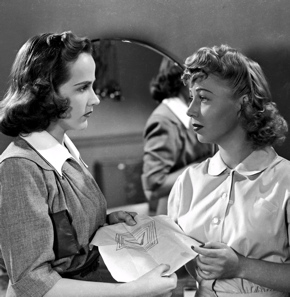
Steve Haberman's witty commentary gathers up all the known data on the film (which is still not extensive) and adds his own very good ideas. He translates La Sagesse as "the way", when Savant rather foolishly assumed all these years that it meant 'wisdom.' He also does a nifty interpretation of the Palladist's modernistic trademark -- if you had a secret society, would you use its sacred symbol as your company logo? Haberman not only decides that Mrs. Redi is a lesbian, but outs Miss Gilchrist (the cowed woman back at the girl's school) and Frances Fallon as well. I think he goes too far ... female characters should be able to have strong protective emotions and intense interpersonal loyalties without being assumed to be 'coded' lesbians. Then again, perhaps Savant isn't picking up all the clues. Of all of Lewton's films, The Seventh Victim seems the most original. It's rather tame for a tale of devil-worship but it cuts through to the center of the human dread of loneliness and alienation, the chill that comes when one starts to believe that the effort and strain of trying 'to live in the world' just isn't worth it. It's an existential statement about a creeping despair for which we don't have a precise word. Val Lewton sounds like a troubled person under his creative drive and great personal integrity, but I think the morbid lessons of The Seventh Victim are actually very positive: Have courage, form meaningful relationships and stay away from the dark phantoms, and you might be okay. 1 
The Ghost Ship 1943 / 69 min. / Co-billed with The Leopard Man; not available individually Starring Richard Dix, Russell Wade, Edith Barrett, Ben Bard, Skelton Sknaggs. Cinematography Nicholas Musuraca Art Direction Albert S. D'Agostino, Walter E. Keller Film Editor John Lockert Original Music Roy Webb Written by Donald Henderson Clarke Directed by Mark Robson The Ghost Ship has a uniquely strange history. Almost immediately after its release a suit was filed claiming that Lewton had seen and copied a script that had been submitted to the studio. The front office was willing to settle but Lewton insisted on a court fight. RKO lost and as a result the movie had to be withdrawn from distribution. It became a Ghost Film, disappearing from authorized public performances for four decades. In his book, Joel E. Siegel talked about having to track down an old print to a rural TV station in Kentucky. In the early1970s the "normal" Lewton films weren't always easy to see. Savant memorized Siegel's chapter on The Ghost Ship convinced the film would never surface. The Ghost Ship showed up suddenly in 1991 or so and Savant caught it at a truly haunted Sunday screening. It was included on the earlier laserdisc boxed set. The Val Lewton Screenplay Collection site has some original documentation on the lawsuit. The Ghost Ship is a fine thriller that casts fading matinee idol Richard Dix as a demented sea captain. Young actor Russell Wade had a bit in The Leopard Man and here gets his chance at a leading role. He's not all that great an actor but he has an open quality that Lewton must have liked.
This time out Lewton more or less defines the modern concept of the psycho killer, fifteen years before the movies The Night Runner and Psycho gave us 'horror of personality' madmen that behave normally in most circumstances. If the story is influenced by anything, it's Jack London's The Sea Wolf, but the later The Caine Mutiny might owe it a few ideas. Richard Dix's Captain Stone is a calmly functioning lunatic who casually plots the demise of crewmen that he feels are disloyal. Dix's Stone is a groundbreaking psycho killer character -- in 1943 movie 'madmen' were likely to be simple evildoers with ordinary excuses like greed or lust. Stopping off in a South American port, Stone meets his girlfriend (Edith Barrett without the old-age makeup of I Walked with a Zombie) and tells her that he fears he's going insane. That makes The Ghost Ship practically the first movie since Fritz Lang's "M" to seriously tackle a psychotic's perplexed state of mind. Young Merriam alone can see the madness because Stone confides in him, stating his twisted philosophy: A Captain is responsible for the lives of his crew and therefore has the authority to take those same lives. A complaint by an unhappy sailor (young Lawrence Tierney in one of his first parts) results in a macabre death trapped in an anchor-chain compartment as it fills up with crushingly heavy iron links. When Merriam tries to call attention to the mad captain, he finds himself shunned as a Jonah. The Ghost Ship also has a rather gruesome knife fight when Dix attacks mute Finnish sailor Skelton Knaggs. We see a stomach slashed, and Knaggs holds onto Dix's blade while blood runs out of his hand. In a wonderfully moody conceit, the movie ends and begins with a stream-of-consciousness narration from the mute Finn, in which he dedicates himself to Merriam's protection. As might be guessed, The Ghost Ship is in fine shape. It has no real history of distribution and the film elements sat undisturbed for over forty years. Savant has a beautiful original poster for the film bearing a 1948 release date -- obviously the RKO department that generated posters prepped it for reissue not knowing it was legally un-releasable. The disc has no extras. It's logical that a re-issue trailer doesn't exist for this one but also sad that nobody could be lined up to do a commentary for it. 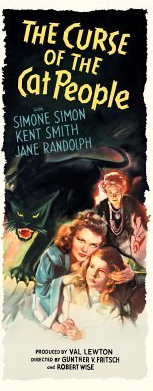
The Curse of the Cat People 1944 / 70 min. / Co-billed with Cat People Starring Jane Randolph, Kent Smith, Simone Simon, Elizabeth Russell Cinematography Nicholas Musuraca Art Direction Albert S. D'Agostino, Walter E. Keller Film Editor J.R. Whittredge Original Music Roy Webb Written by DeWitt Bodeen Directed by Robert Wise and Gunther von Fritsch Critic James Agee held out special praise for The Curse of the Cat People, surprised to discover a sensitive and psychologically valid examination of a child's adjustment problems. Although meant to be a sequel to the original horror hit, Lewton came back with a completely different kind of psychological thriller. The idea of a kid unable to tell reality from fantasy became a commonplace in 50s TV dramas. This carefully crafted film, much of it seen from a child's point of view, thwarted the expectations of horror audiences yet still won them over. Started by one director and finished by Robert Wise in his first feature assignment, its style is consistent with the rest of the Lewton pictures, firmly establishing who was in charge.
It must have seemed like a Curse from the Front Office. Lewton did the impossible with Cat People only to be handed a half-baked sequel title so ludicrous, Neal Simon used it twenty years later in The Odd Couple:
Walter Matthau: "Let it be on my head?! What is this, The Curse of the Cat People?!" The Curse of the Cat People's sensitive screenplay is so ahead of its time, the movie stays fascinating despite some weak acting and general awkwardness. Sir Lancelot seems unusually stiff and the threat over at the Ferren house is underdeveloped. Elizabeth Russell's role as a potentially murderous woman seems way out of kilter for the rest of the movie. Despite our fondness for her earlier appearances in the series, she doesn't come off well. 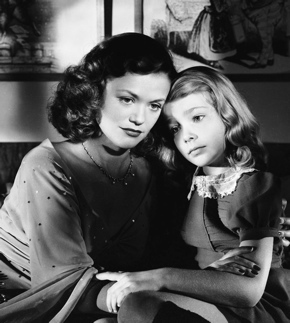
Little Amy Carter does come off well, and it's a safe bet that doomed director Gunther von Fritsch used some of his too-slow working time to coax a particularly good performance from her. It's interesting that Robert Wise would get his break by being the company man who comes in to save the day. He'd already performed a clean-up (or sabotage) job on The Magnificent Ambersons for the suits in the front office. Wise's career was based on seeing his producers safely through to their bottom line, often coming in early on pictures. On his first of two musical successes, West Side Story he was hired to keep an 'artistic' director on schedule and ended up surviving that director's firing as well. As Gregory Mank explains in his fine commentary, more than half of the film is the work of Gunther von Fritsch. One had to be more than good in Hollywood, one had to be fast. Only a couple of times does psychology intrude on the proceedings. The teacher says something laughable about Amy to Alice to the effect of, "A first spanking is a very important thing." The psychological content is accurate to progressive ideas of the time and free of the smug attitudes that would be associated with the same ideas a bit later in the 1950s. James Agee pointed out the ghostly Ms. Simone's slightly Oo-La-La costume, which only seems so because of the deletion of a short scene of Amy reading a storybook -- Amy "created" the Irena we see by combining a photo of Oliver's first wife with a book illustration of a princess in a similar costume. As happens with vintage RKO titles, the ones reissued less frequently tend to be in the best condition. The Curse of the Cat People looks very good, with almost no wear. Roy Webb's musical compositions adapted from the first film sound particularly fine on the audio track. Greg Mank's commentary smoothly lays out revelations, such as the content of the original unused ending. He also gives us the sad information that actor Erford Gage of The Seventh Victim, after finishing a tiny bit in Curse, shipped out as a soldier and was killed in action on Iwo Jima. A very dupey reissue trailer is included. 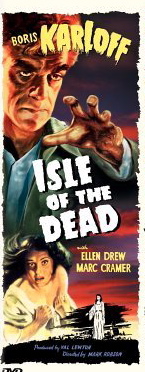
Isle of the Dead 1945/ 72 min. / Co-billed with Bedlam Starring Boris Karloff, Ellen Drew, Marc Cramer, Katherine Emery, Jason Robards Cinematography Jack McKenzie Art Direction Albert S. D'Agostino, Walter E. Keller Film Editor Lyle Boyer Original Music Leigh Harline Written by Ardel Wray, Josef Mischel Directed by Mark Robson They can't be all winners, and while Isle of the Dead has its good points it's easily the least of the Lewton films. It was a bad luck picture all the way, as Lewton's new star Boris Karloff had back trouble that delayed the shooting so long that actors were no longer available. The Body Snatcher was filmed before this one was finished.
Compared to the other films, not much of interest happens in Isle of the Dead. Karloff's character goes slightly nuts worrying about the plague and starts to believe ancient Greek superstitions about vampire-like demons. Katherine Emery does a quick run-through of Poe's Premature Burial plotline. For the rest of the running time a number of characters stroll about some particularly non-atmospheric sets - the movie looks as if it were designed to cost next to nothing. Boecklin's painting Isle of the Dead had made an appearance in I Walked with a Zombie (it's in the still above) and is duplicated for this film to characterize the graveyard island as a poetic substitute for the underworld. Beyond that, there's little poetry or further complication to keep our attention. The main thrill takes place in the last act, where Mark Robson gets some nice mileage out of Emery being shut up alive in a burial crate. A few chills ensue as she wanders about, inexplicably trying to kill people. Apparently Warners couldn't raise much excitement about Isle of the Dead either, for the disc has no extras, not even the reissue trailer that has Boris balefully intoning, "No one may leave the island" at least five times. The transfer is fine as the vault materials appear to be in very good shape. 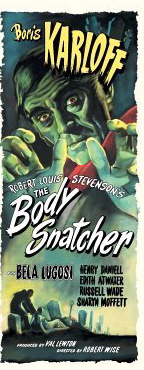
The Body Snatcher 1945 / 78 min. / Co-billed with I Walked with A Zombie Starring Boris Karloff, Henry Daniell, Bela Lugosi, Russell Wade, Edith Atwater, Rita Corday Cinematography Robert deGrasse Art Direction Albert S. D'Agostino, Walter E. Keller Film Editor J.R. Whittredge Original Music Roy Webb Written by Philip McDonald, Carlos Keith Directed by Robert Wise After an executive shuffle RKO seemed to forget that Lewton practically saved the studio single-handedly with Cat People. On Isle of the Dead and The Body Snatcher they changed his production profile, actually doing him a big favor. Boris Karloff was hired and the films were to be period pieces, perhaps with a few more dollars in the budget. Lewton rankled at being told what he had to produce but found that he got along exceedingly well with Karloff. The movie turned out to be one of the better Lewtons, and Karloff may give his best film performance this side of the original Frankenstein.
Lewton's writing contribution to The Body Snatcher was so substantial that he gave himself a credit under his sometime nom de plume Carlos Keith. His adaptation of the basic Burke and Hare resurrectionist story is an excellent example of how gory and sordid material could be reshuffled into a form acceptable to 1945 censors. There are other 'straight' tellings of the same tale (The Flesh and the Fiends, 1959 and The Doctor and the Devils, 1985) but Lewton bests them by managing a shocker of an ending that really surprises audiences. Boris Karloff and Henry Daniell are given scenes they can really sink their teeth into; it's possibly Daniell's finest hour as well. Gray and MacFarlane are a strange pair of symbiotic ghouls. One has respectable breeding, high ideals and a lofty station in society, and the other is a verminous lowlife that long ago chose scraping out a living over higher morals. Gray lives in gutters but he has his pride, and once he gets his hooks into MacFarlane nothing can get him to let go. Karloff made so many films that wasted his potential, it's really gratifying to see him cut loose and show what he can do. Sitting alone in his stable or downing a pint, his bitterness comes out in long speeches and shows though his feigned friendliness. "I'd like to do this all over his body" Gray says of MacFarlane as he punctures a piece of bread with his knife. Karloff's lisp adds to his character. Unlike the greedy ghouls of the other body-snatching movies, Gray has more on his mind than money. He's the raw material for a lower-class revolution, unable to channel his hatred and resentment into anything productive. Karloff would play an even more complicated character in Bedlam. Bela Lugosi has little to do and it's pitiful to see him stuttering through scenes completely overwhelmed by the 'upstart' who took over the mantle of horror king so many years before. Russell Wade, Elizabeth Russell and other actors seem more like peripheral support, something that makes the subplot about curing a little girl's injured back seem more ordinary and less inspired. Because of its star casting The Body Snatcher is no longer an impoverished B Picture. Savant once read a publicity-oriented Life magazine article that indeed called Lewton the 'Sultan of Shudders." The Body Snatcher was extremely popular and was probably printed to death for reissues. It looks much better on DVD than it did on laserdisc but is still not as beautiful as the other titles. It's just a matter of film generations -- a little more contrast and a little less detail. Robert Wise contributes a commentary about his career and the Lewton experience that I believe is taken from the older Image laserdisc. Steve Haberman is also heard on the track. Another reissue trailer is included. Just to give the Warners copy people grief, let me add that the back-cover credit block gives billing to an actor named "Russell Wad. " This is an unfortunate error; Russell Wade never got near the adult film industry. 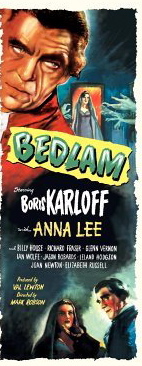
Bedlam 1946 / 79 min. / Co-billed with The Body Snatcher Starring Boris Karloff, Anna Lee, Billy House, Richard Fraser, Glenn Vernon Cinematography Nicholas Musuraca Art Direction Albert S. D'Agostino, Walter E. Keller Film Editor Lyle Boyer Original Music Roy Webb Written by Carlos Keith, Mark Robson Directed by Mark Robson Lewton's horror career ended on a fine note with Bedlam, an accurate and spirited historical recreation that shows him capable of doing period pictures better than practically anybody. It's too bad that those kinds of films weren't a growing trend in the late 1940s -- Lewton stumbled when he attempted contemporary comedies. It's entirely possible that Lewton's free hand in making such creative films was really a wartime phenomenon - the studio had too much on its agenda to worry about one little B-Picture unit.
Fans like the more violent The Body Snatcher but the classy Bedlam is just as good. We get menace in a number of sophisticated forms, all related to power and influence in an unjust society. Smart-mouthed Nell Bowen's sass is encouraged until her criticisms inflame her rich benefactor. The scheming Master Sims has her committed as soon as he figures out an angle to denounce her as insane. The story is less about Good versus Evil than about meanness versus enlightenment. Richard Fraser's Quaker gives Nell sound advice and an excellent Christian example, and she transforms from a selfish butterfly into a social progressive. Even Sims is left un-demonized. He's merely another powerless man performing his malice to maintain a shaky station in a system where favor can be found only by flattering vain men of power. The asylum is a scary place but writers Robson and Lewton (using his Carlos Keith name) slip in dozens of sly jokes. A dissolute writer is incarcerated just so he can stay away from liquor and support his family ... Lewton used to hole up in tiny hotel rooms out of town when he needed to come up with an entire book over a weekend. A madman who thinks he's a lawyer demonstrates the idea of animation and even movies, and is told that he really needs to be locked up. At Master Sims' kangaroo trial, one strange inmate repeats a single line of dialogue: "Split 'em in two!" Hinting at sexual molestation, Master Sims always greets the silent woman he calls 'The Dove' by stroking her cheek. She just stands and stares, as if a traumatic rape was what got her into Bedlam in the first place. The exciting conclusion puts Nell in the precarious situation of having to depend on a mindless giant to help her escape, while Sims suffers the revenge of his inmates. The film is capped by a subtle, horrific shot that ends nine Lewtons on a high note. Bedlam charms people who don't normally care for screen horror. The transfer of Bedlam is a good one, although once again we would have loved to see some of these films given a more active restoration. Roy Webb's careful score with its gentle period flavor sounds fine on the clear track. Freezing on transitions will give viewers the ability to examine the Hogarth engravings that are seen only briefly across dissolves. Tom Weaver lends this disc an exhaustively fact-packed commentary that subjects Lewton, his films and Bedlam to a good examination. It then goes further to uncover facts about the history of St.Mary of Bethlehem hospital and the commercial career of artist Hogarth, who actually waited for a copyright law to pass before publishing his series of 'exploitation' engravings called Rake's Progress. Weaver dispenses facts so quickly that we barely have time to absorb them, and the accuracy of his research ensures that we Lewton fans who have read a book or two will still be amazed at how much more there is to know. Talking fast and somehow staying on point without even pausing to breathe, Weaver is an object lesson on how to deliver a research-based commentary. There's no reissue trailer for Bedlam either, but I don't remember seeing that particular one before. The Val Lewton Collection has been on DVD fan lists for a long time and will be a prized possession for many even if the sales don't reach the heights of boxes for Alfred Hitchcock or the Astaire-Rogers musicals. The transfers are reasonable to good, with some measure of disappointment that none of the titles have been given an extensive restoration. I have a feeling that the narrower demographic for exotic 1940s horror films is responsible for that not happening just yet. Savant doesn't have a good answer for people wanting to know which titles to buy to avoid getting the whole set -- The Seventh Victim is a must-see that isn't available individually. The Seventh Victim disc contains as a co-feature New Wave's docu Shadows in the Dark: The Val Lewton Legacy. The show, which contains a lot of information and many impassioned interview bites from notables including Lewton's son and Robert Wise, is too much of a good thing and tends to sag. The same stills of Lewton are recycled too often. It's odd to know how to pitch film docus on such specific subjects -- fans really interested in this much detail on Val Lewton are likely to simply go to the good books about him, and casual viewers stand to have all nine of the horror films ruined by the ample spoilers. Lewton made two non-horror pictures in the middle of these thrillers. Youth Runs Wild is a fascinating proto- delinquency flick that fixes the origin of the social problem ten years before the rest of Hollywood discovered troubled teens. Mademoiselle Fifi is a good low budget De Maupassant adaptation with an excellent Simone Simon. Half of the story comes from the same source as John Ford's Stagecoach. Curiously, the docu dismisses these interesting pictures to concentrate on the horrors, and seems to agree with Lewton's small-minded studio bosses that he was unqualified to do anything else. Like Preston Sturges, Lewton flourished in a very specific environment ... and even then he ruined his health trying to keep his career together. Film students are drawn to Lewton to see how he made 'A' level movies on 'B' picture budgets, but with few exceptions his pictures don't offer the answer to brilliance without resources. Lewton may have been cash-poor but he had access to formidable studio departments itching to contribute to something better than Falcon detective movies. The real brilliance in Lewton's films comes from his storytelling talent and his creative independence - few studio producers before or after had as much creative freedom - a blessing much more valuable than the size of a budget. On a scale of Excellent, Good, Fair, and Poor,
|
||||
|
|
||||
|
|
||||
|
|
||||
|
|
||||
|
Reviewed: September 9, 2005 Footnotes:
1. The influence of The Seventh Victim can be seen all over, and his admirers seem to include Orson Welles and Carol Reed. Compare the 'doorway reveal' of Harry Lime in The Third Man with Jacqueline Gibson's momentary appearance in a doorway in Victim. Pretty similar, wouldn't you say? Both characters are the subject of mystery searches by naive protagonists.
More weirdness: Savant picked up on a crazy hairstyle relationship between The Seventh Victim and two science fiction thrillers made much later by Bertrand Tavernier and Wim Wenders. See This link and scroll down through the graphics.
Review Staff | About DVD Talk | Newsletter Subscribe | Join DVD Talk Forum |
|
| Release List | Reviews | Price Search | Shop | SUBSCRIBE | Forum | DVD Giveaways | Blu-Ray/ HD DVD | Advertise |





